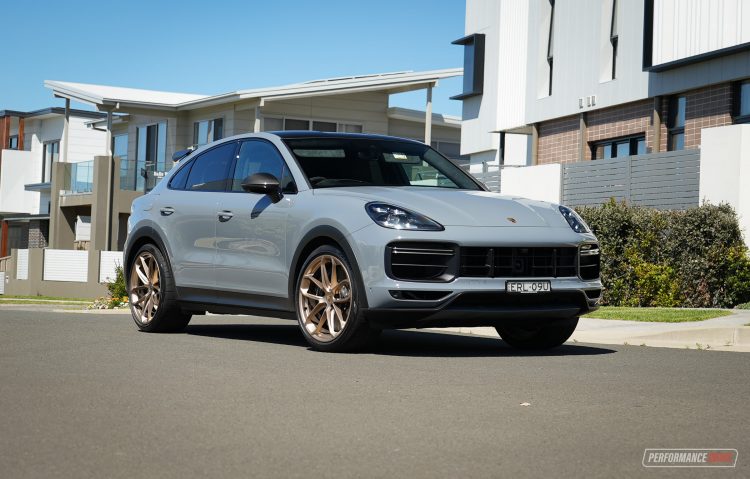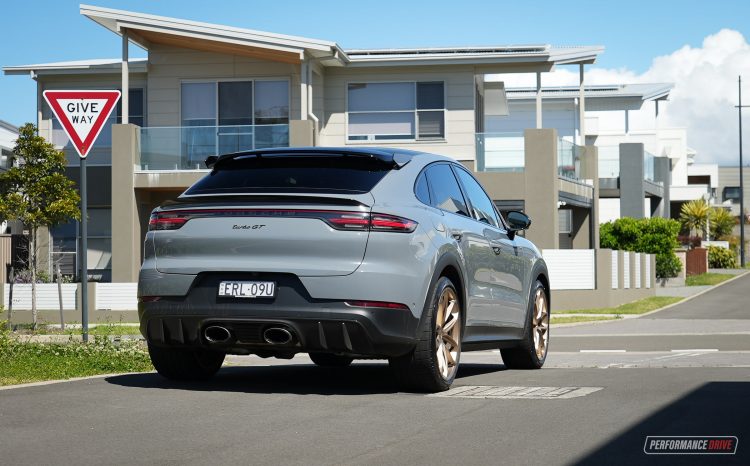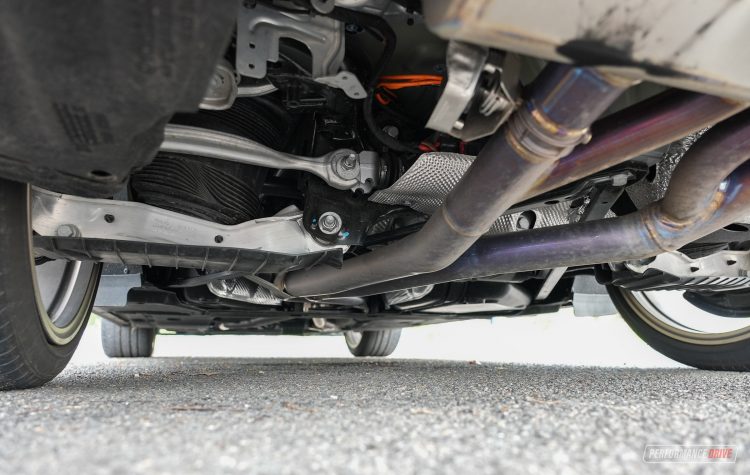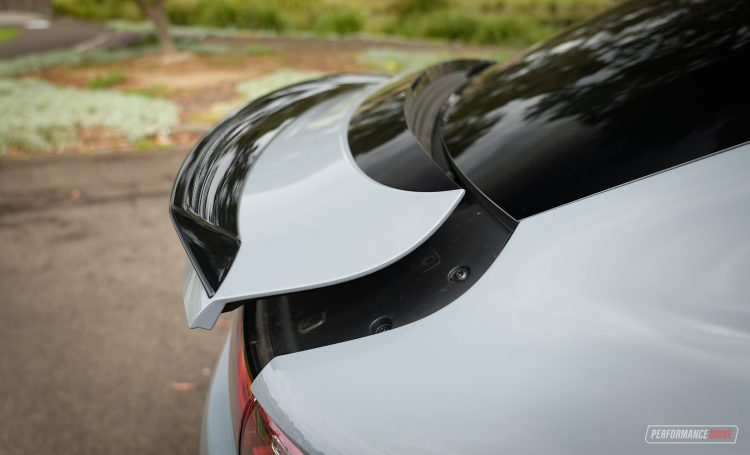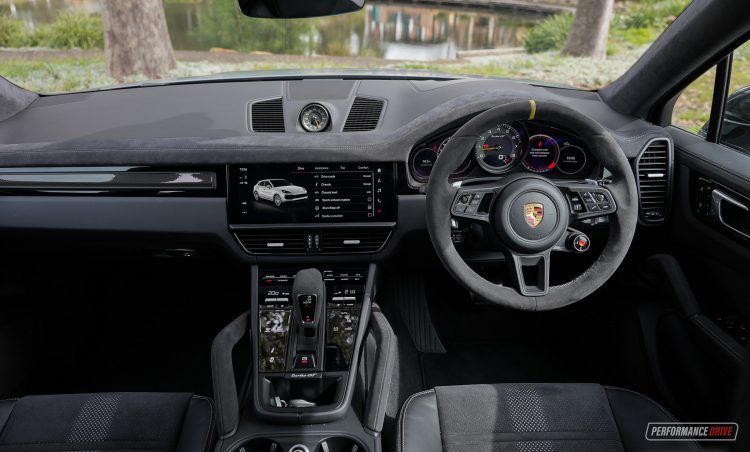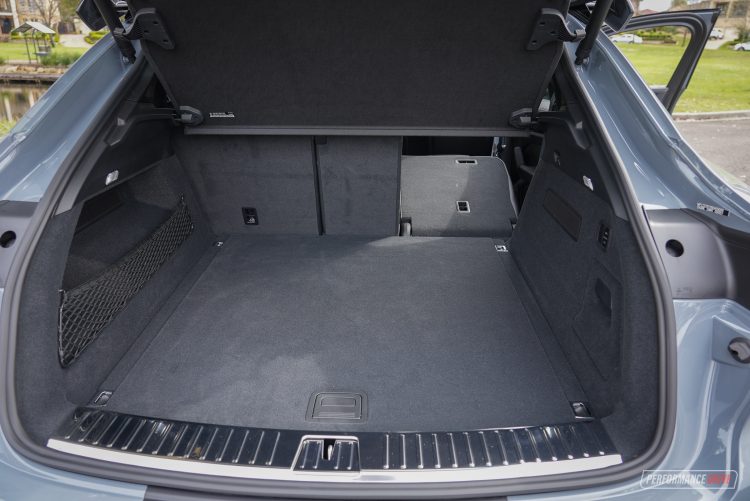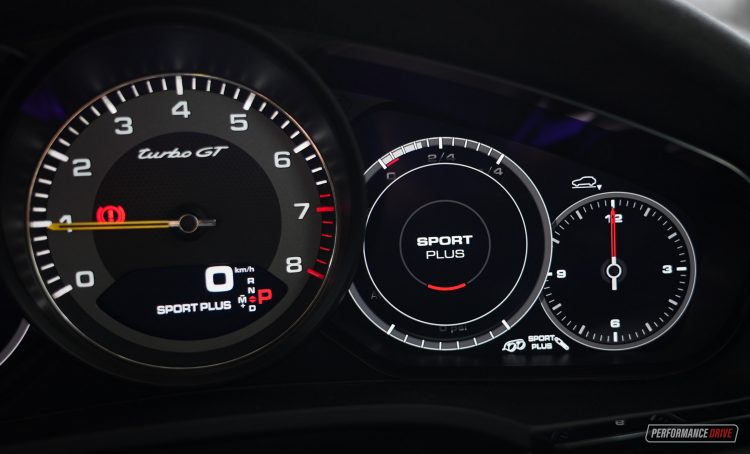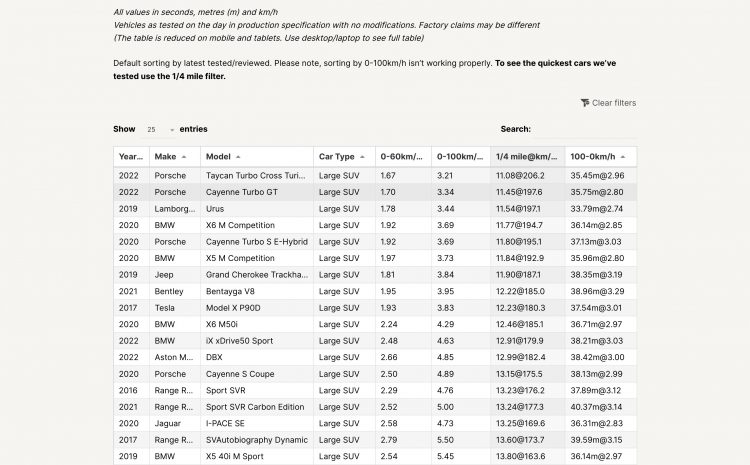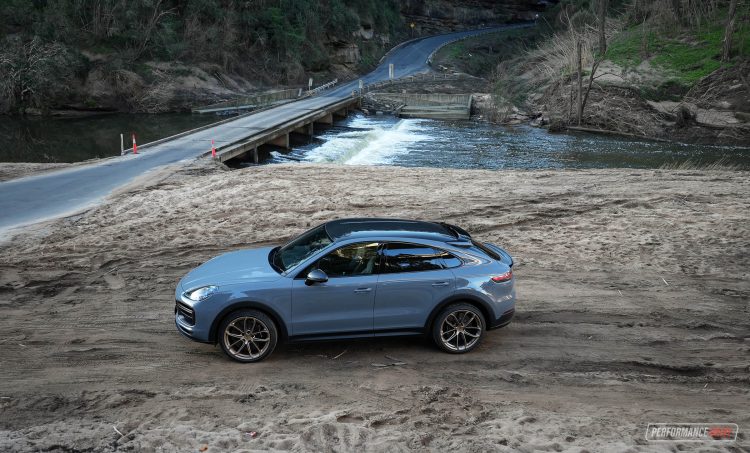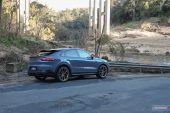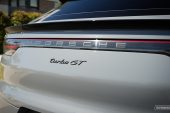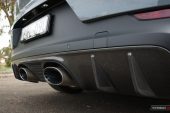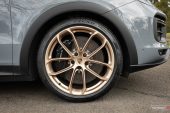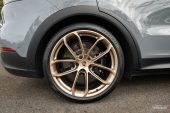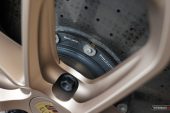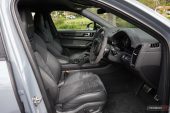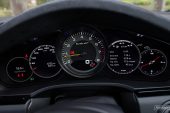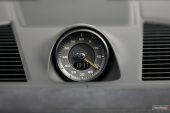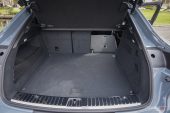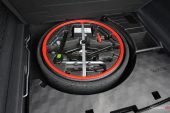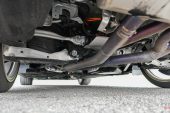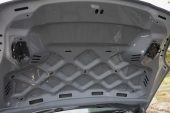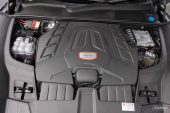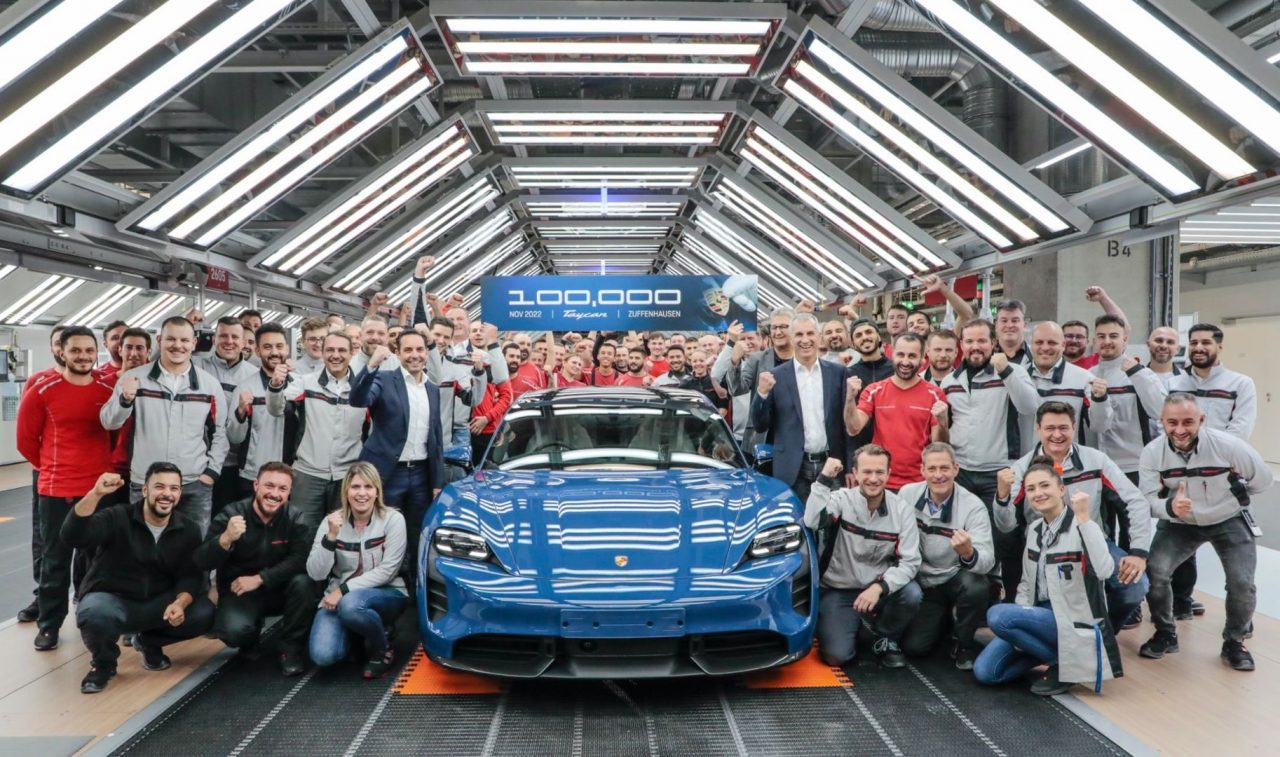When we think of the fastest and quickest-accelerating cars on the new-car market, it’s rare that we ever consider an SUV. But every once in a while a car brand will launch a bonkers model that totally shifts our whole mentality around what we all thought was technically possible from an SUV.
This is one of those rare occasions. It’s the new Porsche Cayenne Turbo GT. Otherwise known as the fastest production SUV to ever lap the Nurburgring, and the second-quickest SUV we’ve ever tested, outright, only behind the Porsche Taycan Turbo Cross Turismo.
Porsche claims this monster dashes from 0-100km/h in just 3.3 seconds. Hang on, this still has a large boot and space for four adults, right? And some level of off-road ability? Yep, to all of that. In fact, this vehicle offers the best ‘bootsize-to-performance’ ratio we’ve ever seen – if that’s a thing. We can’t think of any other vehicle currently on the market that offers over 549L of boot space that also has an official 0-100km/h time of less than 3.3 seconds.
Obviously this incredible breadth of capability doesn’t come cheap. Prices start from $351,900 (excluding on-road costs). That’s about $77,000 more than the Cayenne Coupe Turbo, and, interestingly, about $68,000 more than the Taycan Turbo Cross Turismo.
2022 Porsche Cayenne Turbo GT – THE SPECS
[column width=”47%” padding=”6%”]Engine: 4.0-litre twin-turbo V8
Output: 471kW@6000rpm / 850Nm@2300-4500rpm
Transmission: Eight-speed auto
Drive type: All-wheel drive
Wheels: F: 22×10.5, 285/35 R: 22×11.5, 315/30
ANCAP: Not tested
Tare weight: 2162kg
Power-to-weight: 4.59:1 (kg:kW)
Official fuel economy: 12.6L/100km
Economy during test: 14.9L/100km
Fuel capacity/Type: 90L/95 RON[/column] [column width=”47%” padding=”0″]Power efficiency: 37.38kW:L/100km
0-60km/h: 1.70 seconds*
0-100km/h: 3.34 seconds*
0-200km/h: 11.77 seconds*
60-110km/h: 2.10 seconds*
1/4 mile: 11.45 seconds at 197.6km/h*
Max acceleration: 1.229g
100-0km/h braking: 2.80 seconds at 35.75 metres*
Max deceleration: -1.273g
Decibel at idle (/Sport mode): 46/53*
Peak decibel at 60-100km/h: 92*
Priced from: $351,900[/column][end_columns]
* Figures as tested by PerformanceDrive on the day. Factory claims may be different
2022 Porsche Cayenne Turbo GT – THE PACKAGE
The Turbo GT comes in as the new flagship for the Cayenne Coupe lineup, sitting above the Cayenne Turbo and above the 500kW Turbo S E-Hybrid beast. We suspect Porsche wanted to show the world the full extent of what it could do with the SUV formula with this GT, claiming the Nurburgring record as unequivocal certification. And that’s awesome if so. We should welcome enthusiastic car brands that have the passion to push the boundaries. Otherwise the new-car market quickly becomes a very boring place.
Porsche has infused a high level of attention to detail into the new variant. Every part and every surface is honed for absolute performance. There’s a bespoke aero package for the body, for example, incorporating a deeper front spoiler and bigger intakes to aid downforce and cooling, respectively. At the back is an active rear wing that gets deployed automatically during heavy braking or in certain drive modes. The wing is complimented by a large lip spoiler measuring 50mm, up from 25mm on the Cayenne Coupe Turbo, providing around 40kg of downforce for the rear axle.
A completely bespoke air suspension system has been devised to offer the agility of a small sports car – despite weighing 2162kg (tare) – while also providing excellent grand touring comfort. The three-chamber air suspension system is more rigid, by about 10 per cent in Normal mode and 15 per cent in Sport Plus mode, than other Cayenne air suspension setups.
Some longer helper springs have also been fitted, as well as stiffer damper mountings for the rear, and firmer damper tuning at the front. Porsche says it has set up the suspension characteristics to offer a comfortable ride in Normal mode while offering a higher roll stability, increased road-holding, and a more precise turn-in over the regular Turbo.
This level of painstaking engineering and fine-tuning goes on and on. There’s a water-cooled system for the eight-speed auto transmission which is not featured on any other Cayenne. It’s there to back up the GT’s intense performance on the track so it can repeat lap after lap without overloading the gearbox, mechanically or thermally. The rear-axle steering system, which is standard on the GT, has been tuned specifically for the massive tyres, too.
And yeah, check out those gob-smacking wheels. They measure 22 inches in diameter, and 10.5 inches wide on the front and 11.5 inches wide on the back. Providing seemingly endless grip are bespoke Pirelli P-Zero tyres, sizing in at 285/35 on the front and 315/30 on the back. Hiding behind are a set of Brembo-made 440mm front and 410mm rear carbon ceramic brakes, with 10-piston calipers on the front. Yep, 10. Four-piston units clamp the rear.
Various panels and parts are made from carbon fibre as well, including the roof, which saves 22kg and helps to lower the centre of gravity. The ride height is 17mm lower than the regular Turbo model, again, helping to increase agility and cornering speed potential. It also gives the Cayenne a really low and fat stance. Porsche says it paid special attention to ensure the wheels/tyres don’t scrub the guards, even during “the most dynamic driving manoeuvres”.
Despite all of the craziness on the outside, the Turbo GT presents a very suave and pleasant cabin environment on the inside. Lots of Alcantara has been applied for that soft yet sporty look and feel, while the driver gets to play with a bespoke steering wheel featuring a yellow centre stripe. You’ll find gold-coloured contrast stitching on various fixtures as well. The colour is called Neodyme and has been designed to match the finish on the wheels.
Up on the dash is a 10.9-inch touch-screen running Porsche’s sixth-generation operating system, known as PCM 6.0. It includes wireless Apple CarPlay and wired Android Auto, and provides a range of in-built apps and car settings pages to play around with. We’re not a big fan of the menu layout Porsche adopts. It’s all very nice and neat, and loading times are prompt, but some of the functions within the screen are scattered almost randomly over the screen’s real estate.
Sometimes you’ve got different drop-down tabs from the top that go into separate detailed settings, depending what area you’re in, and some of the main settings sprout out from the middle or from off-set sections of the screen. Maybe we’re just used to seeing a more civilised and logical list or flip-page-like sequence. It doesn’t take long to understand where everything is though, and you soon flick around without even looking. The mostly-dark graphics suit Porsche’s subtle and understated in-car design heritage.
Passenger space is plentiful, with a typically precise and tidy layout for the main fixtures and physical controls. Rear passengers are slightly impacted by the swooping coupe roofline getting in and out, but once you’re in it is pretty much the same as the regular wagon model, at least for average-height people. Fully independent climate control and multiple charging ports are sure to keep everyone happy.
Boot space is slightly smaller than the regular coupe models, dropping from 600L to 549L. It’s a big space nonetheless, and totally suitable for running daily errands or to store luggage for a big weekend away. Again, considering the GT’s physics-bending performance, to have a boot at all is a real bonus.
2022 Porsche Cayenne Turbo GT – THE DRIVE
Under the bonnet is the most powerful V8 engine Porsche has ever made for a road car. It belts out a colossal 471kW and 850Nm. Compared with the regular Turbo engine, various internals have been replaced with higher-performance items, including a unique crankshaft, conrods, pistons, and even the turbochargers are larger, peaking at 1.6 bar (about 23 psi). The sound it produces is almost frightening. It’s like an earthquake rumbling fiercely towards you.
There is a switch for an exhaust valve so you can make it louder or quieter to suit the mood, and there’s a separate drive mode toggle on the steering wheel with a very tempting red button in the middle. Push this and you’re given about 20 seconds of afterburner, making overtaking on or off the track even easier. Not that you’ll have a problem with acceleration in any situation.
Push your foot hard into the accelerator and the transmission with swiftly knock back a couple of gears and propel you with serious, gut-wrenching force. It is so savage, and not just off the line. The Cayenne Turbo GT keeps pulling and pulling, like a high-end sports car going down a very steep hill. The g-force is insane. In fact, according to our Racelogic Vbox, you can experience up to 1.229g during acceleration. Have a think about that for a moment. 1.2g is similar to what you’ll experience on some rollercoasters. And this is a big, family-friendly SUV.
In the hands of Porsche’s test driver Lars Kern, the GT has lapped the Nurburgring in 7:38.925. For perspective, the Lamborghini Urus has lapped the circuit in 7:47, while the Lexus LFA V10 clocked it in 7:38, as did the Ferrari 458 Italia, as did the 997 Porsche 911 Turbo. Perhaps the best trumping of all, the Turbo GT’s time is quicker than the original 1000hp Bugatti Veyron (7:40). Validity doesn’t get much higher.
According to our performance results database – with around six years’ worth of real-world acceleration figures in it – the quickest SUV we’ve ever tested is the Taycan Turbo Cross Turismo. It crossed the 0-100km/h benchmark in just 3.21 seconds when we tested it earlier this year. The Lamborghini Urus (2019 model) is in second place with a time of 3.44 seconds. We tested this Cayenne GT, trying out various take-off methods and drive modes, and the best result was 3.34 seconds. So, it becomes the new second-quickest SUV on our leaderboard. Interestingly, it’s only just behind the time we saw with the Panamera Turbo S (3.18 seconds).
Out on a spirited road it honestly feels like you’re driving a much smaller vehicle. It certainly doesn’t feel like it weighs 2.1 tonnes. And much of this is thanks to the comprehensive suspension package, and the rear-axle steering. At low speeds the rear wheels pivot in the opposite direction to the front. But on higher-speed sweeping bends, they pivot in the same direction as the fronts. It might sound complicated, but don’t worry. You don’t have to think about it or do anything different. It sorts itself out automatically, on the go. And what you end up with is the epitome of handling and stability for a road-going SUV.
Also helping with handling is the standard, and exclusively-tuned Porsche Torque Vectoring Plus system. The system offers targeted brake interventions to maximise traction during acceleration exiting corners, and there’s a fully variable differential lock that works its magic to lock up the wheels when needed. Basically, you won’t hear a peep from the tyres when pushing hard away from corners, even if you give it a proper kick in the guts really early in the apex. If you do this though, be prepared to hang on firmly, as it literally rips you and the vehicle around the corner much faster than you’re likely to anticipate.
This colossal level of performance needs to be controlled and harnessed for it to be fully enjoyed. Unlike some very high-powered SUVs and even new EVs out at the moment, the Cayenne GT is a precision instrument that has been fine-tuned for absolute balance. You can really rely on those massive brakes, for example, and they offer excellent feel and feedback, while the steering is enticingly communicative, relaying all of the information you need to enjoy a secure and confident journey. We did some 100-0km/h tests and it returned consistent and repeatable distances around 35-36 metres, with our best recording of just 35.75m.
2022 Porsche Cayenne Turbo GT – THE VIDEO
2022 Porsche Cayenne Turbo GT – THE VERDICT
This is not some sticker pack special edition or a more powerful version of an existing performance model just for the sake of being more powerful. The Turbo GT completes resets your mind regarding what you thought was possible from an SUV, and literally resets many benchmarks for the SUV market segment. It can indeed be a sports car, an utterly brilliant and exciting one, while also offering the comfort, space and practicality that SUVs are renowned for.
[column width=”47%” padding=”6%”]PROS:
– Features the most powerful V8 Porsche has even made for a road car
– Devastatingly fast from point-to-point; it’ll put your brain into limp-home mode
– Elite street tuner looks
– Hardly any sacrifice on practicality
[/column] [column width=”47%” padding=”0″]CONS:
– Do you really need an SUV that’s quicker around the Nurburgring than a Ferrari 458 Italia? Probably not, but we still want one[/column][end_columns]
As always, if you’re thinking about buying a new car don’t forget to click here to speak with our car buying specialists.
